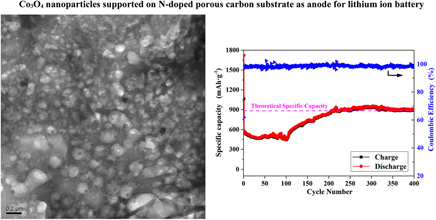Crossref Citations
This article has been cited by the following publications. This list is generated based on data provided by
Crossref.
Balach, Juan
Linnemann, Julia
Jaumann, Tony
and
Giebeler, Lars
2018.
Metal-based nanostructured materials for advanced lithium–sulfur batteries.
Journal of Materials Chemistry A,
Vol. 6,
Issue. 46,
p.
23127.
Liu, Qian-Li
Jiang, Ye-Hua
and
Li, Xiang-Ming
2018.
The effect of bulk nucleation parameters on the formation of macroscopic grain of the large-scale titanium slab ingot during EBCHM.
Materials Science and Technology,
Vol. 34,
Issue. 14,
p.
1649.
Yue, Ziwei
Li, Haotian
Chu, Jingjing
Qu, Gaoyang
Fu, Chaochao
Li, Xiaowei
Li, Ling
Li, Xiaoting
and
Zhang, Wenming
2019.
Co3O4 nanoparticles embedded in 1D porous N-doped carbon nanofibers derived from ZIFs for high-capacity sodium-ion batteries.
Composites Part B: Engineering,
Vol. 177,
Issue. ,
p.
107400.
Sharma, Neha
Szunerits, Sabine
Boukherroub, Rabah
Ye, Ran
Melinte, Sorin
Thotiyl, Musthafa Ottakam
and
Ogale, Satishchandra
2019.
Dual-Ligand Fe-Metal Organic Framework Based Robust High Capacity Li Ion Battery Anode and Its Use in a Flexible Battery Format for Electro-Thermal Heating.
ACS Applied Energy Materials,
Vol. 2,
Issue. 6,
p.
4450.
Chen, Ling
Deng, Junqian
Hong, Shu
and
Lian, Hailan
2020.
Rapid, tunable synthesis of porous carbon xerogels with expanded graphite and their application as anodes for Li-ion batteries.
Journal of Colloid and Interface Science,
Vol. 565,
Issue. ,
p.
368.
Shobana, M.K.
2020.
Self-supported materials for battery technology-A review.
Journal of Alloys and Compounds,
Vol. 831,
Issue. ,
p.
154844.
Weng, Yi-Gang
Yin, Wen-Yu
Jiang, Miao
Hou, Jin-Le
Shao, Jie
Zhu, Qin-Yu
and
Dai, Jie
2020.
Tetrathiafulvalene-Based Metal–Organic Framework as a High-Performance Anode for Lithium-Ion Batteries.
ACS Applied Materials & Interfaces,
Vol. 12,
Issue. 47,
p.
52615.
Rethinasabapathy, Muruganantham
Lee, Jeong Han
Roh, Kwang Chul
Kang, Sung-Min
Oh, Seo Yeong
Park, Bumjun
Lee, Go-Woon
Cha, Young Lok
and
Huh, Yun Suk
2020.
Silver grass-derived activated carbon with coexisting micro-, meso- and macropores as excellent bioanodes for microbial colonization and power generation in sustainable microbial fuel cells.
Bioresource Technology,
Vol. 300,
Issue. ,
p.
122646.
Nazir, Aqsa
Le, Hang T.T.
Nguyen, An-Giang
and
Park, Chan-Jin
2021.
Graphene analogue metal organic framework with superior capacity and rate capability as an anode for lithium ion batteries.
Electrochimica Acta,
Vol. 389,
Issue. ,
p.
138750.
Weng, Yi-Gang
Zhang, Zhi-Ruo
Ren, Zhou-Hong
Shao, Jie
Zhu, Qin-Yu
and
Dai, Jie
2022.
A high-performance pseudocapacitive negatrode for lithium-ion capacitor based on a tetrathiafulvalene-cobalt metal–organic framework.
Electrochimica Acta,
Vol. 426,
Issue. ,
p.
140828.
Tran, Y B. N.
Nguyen, Phuong T. K.
and
Nguyen, Tuan Loi
2023.
An iron-based metal–organic framework for selective CO2 adsorption and as an efficient anode material for lithium-ion batteries.
New Journal of Chemistry,
Vol. 47,
Issue. 22,
p.
10687.
T. K. M., Prashantha Kumar
Tripathy, Debashis
Aiyer, Hemantkumar
and
Sampath, S.
2023.
A Ternary Metal Oxide-Reduced Graphene Oxide Composite as High Capacity and Durable Anode for Li-Ion Batteries.
Journal of The Electrochemical Society,
Vol. 170,
Issue. 8,
p.
080526.
Wang, Ruo-Nan
Tan, Yu-Chuan
Liu, Wei
Wang, Zi-Yi
Zhang, Jun-Die
and
Zhu, Qin-Yu
2025.
A metal–organic framework with mixed electron donor and electron acceptor ligands for efficient lithium-ion storage.
Chemical Communications,
Vol. 61,
Issue. 11,
p.
2289.
